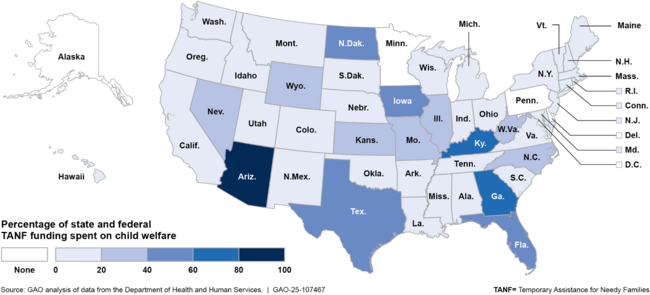Child Welfare: States' Use of TANF and Other Major Federal Funding Sources
Fast Facts
This Q&A looks at how states use federal funds to address child abuse and neglect.
In FY 2015-2022, states spent $23.5 billion on child welfare from Temporary Assistance for Needy Families, a grant that helps families with lower incomes.
During that time, states also spent $68.6 billion from Title IV-E of the Social Security Act, which funds foster care and other family services. This is the largest source of federal child welfare funding. Most state officials we interviewed said they use these funds first because some of their spending can be reimbursed. Most also said TANF funds are more flexible.

Highlights
What GAO Found
Title IV-E and Title IV-B of the Social Security Act are the two largest sources of federal funding that states use exclusively for child welfare (e.g., foster care and other services to prevent or address child abuse or neglect). Temporary Assistance for Needy Families (TANF), a federal block grant, provides states with flexible funds for a range of benefits and services for low-income families and children. States may use TANF funds for child welfare payments to caregivers and for a variety of child welfare services.
According to GAO’s analysis of Department of Health and Human Services (HHS) data, from fiscal years 2015 through 2022 (most recent available for all programs):
- Title IV-E. All states use Title IV-E to make payments to caregivers—foster parents, group homes or other care facilities, or grandparents and other relatives—to cover the cost of care for children in foster care. States spent about $68.6 billion in Title IV-E funds during this period. In 2018, Title IV-E was expanded. States can now use Title IV-E funding for evidence-based prevention services, such as parent education and training. In fiscal year 2022, 14 states used Title IV-E for these services, totaling $35 million.
- Title IV-B. All states primarily use Title IV-B for services designed to protect children; support, preserve, and reunite families; and promote and support adoption. HHS provided states about $4.4 billion in Title IV-B funds from fiscal years 2015 through 2022.
- TANF. States spent about $23.5 billion in TANF funds for child welfare during this period, although states varied in the extent they used the funds for these purposes. According to GAO’s analysis of HHS data for fiscal year 2022, five states reported spending no TANF funds on child welfare and three states reported spending over 60 percent of TANF funds on child welfare. Most states reported percentages of TANF spending on child welfare that were in between, ranging from 1 percent to 20 percent (32 states), 21 percent to 40 percent (seven states), and 41 percent to 60 percent (four states).
Percentage of TANF Funds Spent on Child Welfare, Fiscal Year 2022

In determining which federal funding source to use, officials in all five of GAO’s selected states said they first look to Title IV-E because they are entitled to reimbursement for a portion of all costs that meet Title IV-E eligibility requirements. Officials in four of the five selected states said they use some Title IV-B and TANF funds—which allow for more flexibility—to cover child welfare costs for children and families who are not eligible for Title IV-E. For example, a family’s income could be too high to meet the state’s Title IV-E eligibility requirements, although the family qualifies for support under the state’s Title IV-B or TANF requirements.
HHS administers federal child welfare programs and TANF. HHS provides information, guidance, and technical assistance to states, among other responsibilities. For example, HHS organized an initiative to help child welfare and TANF programs in 10 states and Tribes work together to prevent families from entering the child welfare system. Two of the five selected states, Arizona and Kentucky, participated in this initiative, and state officials said it helped improve interagency communication. In November 2024, HHS also published a public webpage with information for state child welfare and TANF programs, including videos on TANF and child welfare prevention strategies.
Why GAO Did This Study
More than 500,000 children nationwide were found to be victims of child abuse or neglect in fiscal year 2022, according to HHS data. To help ensure that children have safe and permanent homes, the federal government provides states with funding for child welfare programs.
GAO was asked to review TANF spending. In this report, GAO examined states’ use of Title IV-E, Title IV-B, and TANF funds for child welfare purposes. This is the final report in a series of reports addressing states’ use of TANF funds. The other reports in this series examined HHS and state oversight of TANF spending on non-cash assistance (GAO-25-107235) and data states collect on their use of non-cash TANF assistance (GAO-25-107226). GAO also examined TANF fraud risks and HHS efforts to mitigate any risks (GAO-25-107290) and HHS oversight of TANF single audit findings (GAO-25-107291).
GAO analyzed expenditure data states reported to HHS on their uses of Title IV-E, Title IV-B, and TANF for child welfare purposes from fiscal years 2015 through 2022.
GAO also collected information from a nongeneralizable selection of five states (Arizona, Delaware, Kentucky, Texas, and Wyoming). These states were selected based on factors such as their varying proportions of TANF funds spent on child welfare.
In addition, GAO reviewed applicable federal laws, regulations, and other documentation and interviewed federal officials and researchers knowledgeable about TANF and child welfare financing.
For more information, contact Kathryn A. Larin at larink@gao.gov.
